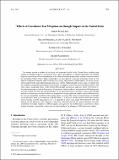| dc.contributor.author | Fitzgerald, Ellen | |
| dc.contributor.author | Neumann, James E. | |
| dc.contributor.author | Martinich, Jeremy | |
| dc.contributor.author | Boehlert, Brent B. | |
| dc.contributor.author | Strzepek, Kenneth Marc | |
| dc.date.accessioned | 2016-02-05T12:24:25Z | |
| dc.date.available | 2016-02-05T12:24:25Z | |
| dc.date.issued | 2015-07 | |
| dc.date.submitted | 2015-05 | |
| dc.identifier.issn | 1948-8327 | |
| dc.identifier.issn | 1948-8335 | |
| dc.identifier.uri | http://hdl.handle.net/1721.1/101108 | |
| dc.description.abstract | The authors present a method for analyzing the economic benefits to the United States resulting from changes in drought frequency and severity due to global greenhouse gas (GHG) mitigation. The method begins by constructing reduced-form models of the effect of drought on agriculture and reservoir recreation in the contiguous United States. These relationships are then applied to drought projections based on two climate stabilization scenarios and two twenty-first-century time periods. Drought indices are sector specific and include both the standardized precipitation index and the Palmer drought severity index. It is found that the modeled regional effects of drought on each sector are negative, almost always statistically significant, and often large in magnitude. These results confirm that drought has been an important driver of historical reductions in economic activity in these sectors. Comparing a reference climate scenario to two GHG mitigation scenarios in 2050 and 2100, the authors find that, for the agricultural sector, mitigation reduces both drought incidence and damages through its effects on temperature and precipitation, despite regional differences in the sign and magnitude of effects under certain model scenarios. The current annual damages of drought across all sectors have been estimated at $6–$8 billion (U.S. dollars), but this analysis shows that average annual benefits of GHG mitigation to the U.S. agricultural sector alone reach $980 million by 2050 and upward of $2.2 billion by 2100. Benefits to reservoir recreation depend on reservoir location and data availability. Economic benefits of GHG mitigation are highest in the southwestern United States, where drought frequency is projected to increase most dramatically in the absence of GHG mitigation policies. | en_US |
| dc.description.sponsorship | United States. Environmental Protection Agency. Climate Change Division (Contract EP-D-09-054) | en_US |
| dc.language.iso | en_US | |
| dc.publisher | American Meteorological Society | en_US |
| dc.relation.isversionof | http://dx.doi.org/10.1175/wcas-d-14-00020.1 | en_US |
| dc.rights | Article is made available in accordance with the publisher's policy and may be subject to US copyright law. Please refer to the publisher's site for terms of use. | en_US |
| dc.source | American Meteorological Society | en_US |
| dc.title | Effects of Greenhouse Gas Mitigation on Drought Impacts in the United States | en_US |
| dc.type | Article | en_US |
| dc.identifier.citation | Boehlert, Brent, Ellen Fitzgerald, James E. Neumann, Kenneth M. Strzepek, and Jeremy Martinich. “Effects of Greenhouse Gas Mitigation on Drought Impacts in the United States.” Weather, Climate, and Society 7, no. 3 (July 2015): 255–272. © 2015 American Meteorological Society | en_US |
| dc.contributor.department | Massachusetts Institute of Technology. Center for Global Change Science | en_US |
| dc.contributor.mitauthor | Boehlert, Brent B. | en_US |
| dc.contributor.mitauthor | Strzepek, Kenneth Marc | en_US |
| dc.relation.journal | Weather, Climate, and Society | en_US |
| dc.eprint.version | Final published version | en_US |
| dc.type.uri | http://purl.org/eprint/type/JournalArticle | en_US |
| eprint.status | http://purl.org/eprint/status/PeerReviewed | en_US |
| dspace.orderedauthors | Boehlert, Brent; Fitzgerald, Ellen; Neumann, James E.; Strzepek, Kenneth M.; Martinich, Jeremy | en_US |
| dc.identifier.orcid | https://orcid.org/0000-0001-9494-785X | |
| mit.license | PUBLISHER_POLICY | en_US |
| mit.metadata.status | Complete | |
